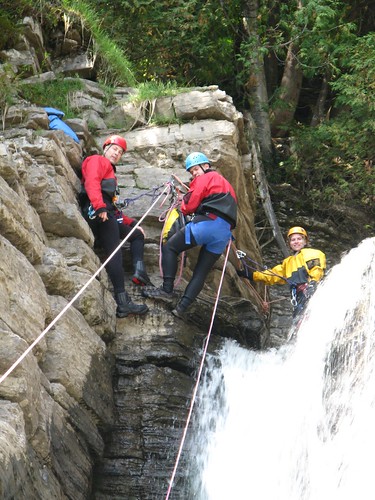
The guns are the scars of the land often wild and inhospitable, kept real challenges as demanding or more, as any other discipline of mountain. The need to understand the environment in which it is practiced driving technique, must be allied with caution when entering the bed of a ravine and down with our own.
The activity of canyoning, like any other mountain sports, requires advance planning. It is advisable to have everything planned and ready one or two days before leaving and always having provided any alternative option, if some factor is impossible to twist and stick with the first plan. The first thing to do before launching an exit route guns would bring the physical form of the practitioner and their technical level, not vice versa. In this way always choose the gun accessible to the person who presents at least.

Having said that, the first thing we will know the type of gun that we do, that is, whether to be a dry ravine or low flow, or a highly water cannon. Generally, the technical level of a barrel mark not only the geomorphology itself (number of rappels, height of these, complicated steps, etc.). But the flow, and movement of water formed following its flow through or against various obstacles (blocks, trees, traps, walls, etc.)..
Confirm access and return with a map of the zone before the downturn, and mark the likely escape holding the gun and the difficulty of these. Keep in mind the times (access, descent and return) by the group and the level of this. Also have an unforeseen change in the weather can hinder the advance until it reached dangerous.
Both the weather and the geomorphology of the canyon, and our understanding of hydrology applied to the cliffs, will be useful once we are performing the activity.
Almost in parallel should be the choice of material we carry on our backs. We must be restrained and not carry more material than necessary, although there are some minimums that we do need to bring:
– Town approved: from those used in climbing.
– Thermal suit thermal insulation of our body.
– Gloves: prevents scratches and cuts.
– Rode Anchor: to our security.
– HMS Carabiner insurance: to abseil.
– Brake: controlled descents.
– Footwear: to protect feet and ankles.
– Whistle: to communicate.
– Knife: cutting ropes.
– Backpack: specifically for canyoning.
– First aid kit: first aid.
– Compass and map of the route guidance.
– Others: thermal blanket, water front, batteries, cigarette lighter, stove, goggles, thermal clothing, food, garbage bag, etc..
Personal Security Protocols:
Are protocols that every climber should do unconsciously in a canyon.
Abseiling Protocol:
– Anchoring the installation to set up the abseil, get a clear picture of the obstacle, understand how to get around as best as possible and safe, aware of everything.
– Attach the string at the eight or «descent» to descend.
– The position in which the climber is found anchored to the installation will not always be comfortable or in low voltage anchor ropes. You should therefore, in these cases, release tension in the ropes to undock and begin to decline.

In cases of being in tension shall be released this tension as follows:
– Retrieve the string to see that the voltage drop anchor baga.
– Rappelling at moderate speed and constantly adapting to technical obstacle to be overcome abseiling.
Nature itself is intriguing and mysterious, becoming incomprehensible at times. In short, it’s full of life and is changing. This gives a duality property that discipline is fun, and both wild and risky.
Good travel!
Leave a Reply
You must be logged in to post a comment.
Recent Comments